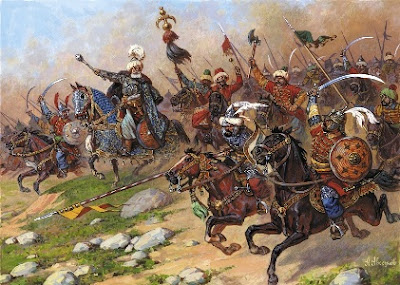Ottomans
While the Ottomans had been expanding out of Anatolia a
different force had been growing in the north to challenge the Byzantine
Empire. In 1331 Stephen Dushan ascended the throne of Serbia and spent the next
20 years building up a Serbian Empire. Just like the Ottomans Dushan had taken
full advantage of the Byzantine succession dispute to conquer much of Albania
as well as parts of Thrace and Macedonia. In 1346 he had himself crowned
'Emperor of the Serbs and Greeks', and invited the Venetians to join him in the
conquest of Constantinople. Rumours that he was interested in reuniting the
Catholic and Orthodox confessions ensured Papal support for the scheme, but in
1355, just as he was about to set off on a grand crusade, Stephen Dushan died.
Dushan's Serbian Empire rapidly started to crumble after his
death, but when the Ottomans occupied Philippopolis in 1363 there was
sufficient glory left in the Serbian name to persuade its defeated commander to
seek help from that direction. A united force of Serbs, Bosnians and
Wallachians joined a Hungarian army under the Hungarian king, Louis the Great,
and marched against the Turks at Edirne. But their rapid advance made the
crusaders lazy. Less than two days from Edirne they made camp on the banks of
the river Maritza and celebrated their progress with feasting. The local
Ottoman commander led his predominately light cavalry arm in an ambush by
night. The Christians fled across the Maritza, which was in spate, and
thousands drowned.
In 1365 the Sultan transferred his capital from Bursa to
Edirne, a move of tremendous significance. To locate one's capital on the edge
of one's territory next to hostile neighbours was an act of enormous
self-confidence, and it proclaimed the sultan's future intentions with profound
clarity, Edirne was also a natural centre of horse-breeding and soon became the
seat of the imperial stables and stud-farms for the cavalry. Long after the capture
of Constantinople it remained a favourite imperial residence.
From Edirne Murad I could look out over his territory as far
as the coast of the Black Sea, a stretch of land that encircled the rapidly
decreasing area dependent upon Constantinople. The toehold in Europe
established at Gelibolu had now been replaced by a mighty presence and a
dramatic statement of intent. The Ottoman advance could now continue from a
firm base. The greatest phase of the conquests was about to start.


No comments:
Post a Comment